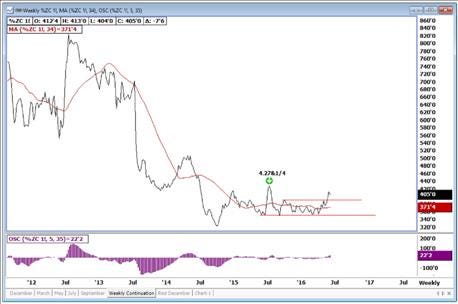
Because we saw a new weekly low close in the fed-cattle market last week, it begins to set some parameters as to the next most probable move.
First, the new low suggests that fats are in wave 5 of 5 on an Elliot Wave chart pattern. (See last week's blogs for more information on that.)
Further downside projections will materialize on a close under $119.70 on the weekly continuation chart. This may also come to fruition on a trade under $116.45 in the June contract.
Until one of the two materializes, my analysis suggests the bottom is in with further upside potential anticipated.

Wave 5 of an Elliott Wave pattern is now in progress. A trade under $116.45 will suggest to anticipate further downside price movement to potentially as low as $111.50. A close on the weekly continuation chart of $123.42 will suggest the wave 5 is complete as well as the entire wave sequence.
The most important price to watch for now, if you are bullish, would be a close on the weekly continuation chart above $123.42. This would then have overlapped the top of the intermediate wave 4 and suggest the 5 wave pattern is complete.
With the perception of a fundamental change having been adopted toward lower weights, the talk of burdensome inventory fades. The industry is perceived moving back toward producing tonnage with numbers over weights.
Feeders must follow
It is the fat market that is anticipated to lead all of the sectors higher. Their job in reducing kill weights is, in my opinion, the key to keeping prices from moving back lower. Feeders are anticipated to benefit from this change in production scheme. So, although feeders are anticipated to move higher, I don't anticipate them to make a mad dash for the $200.00 area anytime soon. What is anticipated is the adoption of the same production process as yards have. That is, to reduce time on feed and keep marketing's current. I know there remains inventory to market for this fall. I will be focused on this as prices move higher. However, at this time, I do not perceive this price to be as advantageous as what is anticipated in the near future. August has already closed above the minor a wave at $146.25. A close above the minor b wave of $149.35 will lead me to anticipate a close above the intermediate wave A high of $150.85. If that materializes, then an equal move of the intermediate wave C to the wave A projects an upside closing target to $160.57.
A word of caution when attempting to market using futures or options at this point. Here is a scenario that may begin to be played out. Although the fats are perceived as friendly, the situation in feeders is pretty bland. What I anticipate to transpire would be for feeder prices to reach a level somewhere between $145.00 and $155.00 over the next few weeks. What may happen then would be for feeders to go stagnant, waiting to see how fats react at the higher prices. This stair step could go on for several months. So, something to watch out for would be attempting to make sales on the futures or buy puts, and not much price fluctuation take place.
An investment in futures contracts is speculative, involves a high degree of risk and is suitable only for persons who can assume the risk of loss in excess of their margin deposits. You should carefully consider whether futures trading is appropriate for you in light of your investment experience, trading objectives, financial resources and other relevant circumstances. Past performance is not necessarily indicative of future results.
About the Author(s)
You May Also Like




